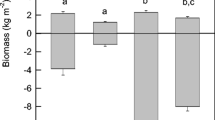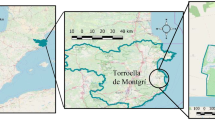Abstract
In a marsh in New Brunswick, Canada, belowground biomass of Spartina alterniflora consistently exceeded aboveground biomass by a factor of approximately 9. Both values peaked in July. Redox potential of the sediment was negative at all levels tested (2, 6, and 11 cm below surface), and was negatively correlated with depth. Concentrations of ergosterol, a sterol typical of higher fungi, were negatively correlated with redox potential and were highest in roots and rhizomes in July and August, 1–3 cm below the surface. These maxima corresponded to a fungal content of approximately 0.6% per ash-free dry mass of Spartina material. Balsa wood panels buried in anaerobic salt marsh sediment were colonized by fungi within 12 weeks. Eight fungal species isolated from S. alterniflora roots did not grow in the absence of oxygen, but were able to grow downward into an anaerobic medium.
Similar content being viewed by others
References
Chanton JP, Martens CS, Kelley CA (1989) Gas transport from methane-saturated, tidal freshwater and wetland sediments. Limnol Oceanog 34:807–819
Cooke JC, Lefler MW (1990) Comparison of vesicular-arbuscular mycorrhizae in plants from disturbed and adjacent undisturbed regions of a coastal salt marsh in Clinton, Connecticut, USA. Environ Manage 14:131–137
Dacey JWH, Klug MJ (1979) Methane efflux from lake sediments through water lilies. Science 203:1253–1254
Dacey JWH, Howes BL (1984) Water uptake by roots controls water table movement and sediment oxidation in short Spartina marsh. Science 224:487–489
Dame RF, Kenny PD (1986) Variability of Spartina alterniflora primary production in the euhaline North Inlet estuary. Mar Ecol Prog Ser 32:71–80
Dickinson CH, Pugh GJF (1965) The mycoflora associated with Halimione portulacoides. III. Root surface fungi of mature and excised plants. Trans Br Mycol Soc 48:595–602
Field JI, Webster J (1983) Anaerobic survival of aquatic fungi. Trans Br Mycol Soc 81:365–369
Fisher PJ, Petrini O (1989) Two aquatic hyphomycetes as endophytes in Alnus glutinosa roots. Mycol Res 92:367–368
Good RE, Good NF, Frasco BR (1982) A review of primary production and decomposition dynamics of the below-ground component. In: Kennedy VS (ed) Estuariee comparisons. Academic Press, New York, pp 139–158
Gosselink JG, Kirby CJ (1974) Decomposition of salt marsh grass Spartina alterniflora Loisel. Limnol Oceang 19:825–832
Gross MF, Hardisky MA, Wolf PL, Klemas V (1991) Relationship between aboveground and belowground biomass of Spartina alterniflora (smooth cordgrass). Estuaries 14:180–191
Hendrarto IB, Dickinson CH (1984) Soil and root microorganisms in four salt marsh communities. Trans Br Mycol Soc 83:615–620
Howarth RW (1984) The ecological significance of sulfur in the energy dynamics of salt marsh and coastal marine sediments. Biogeochemistry 1:5–27
Howarth RW, Teal JM (1979) Sulfate reduction in a New England salt marsh. Limnol Oceanog 24:999–1013
Howes BL, Dacey JWH, King GM (1984) Carbon flow through oxygen and sulfate reduction pathways in salt marsh sediments. Limnol Oceanog 29:1037–1051
Kohlmeyer J, Gessner RV (1976) Buergenerula spartinae sp. nov., an Ascomycete from salt marsh cordgrass, Spartina alterniflora. Can J Bot 54:1759–1766
Kohlmeyer J, Kohlmeyer E (1979) Marine mycology: the higher fungi. Academic Press, New York
Kohlmeyer J, Volkmann-Kohlmeyer B (1991) Illustrated key to the filamentous higher marine fungi. Bot Mar 34:1–61
Mendelssohn IA, McKee KL, Patrick WH (1981) Oxygen deficiency in Spartina alterniflora roots: metabolic adaptation to anoxia. Science 214:439–441
Newell SY (1992) Estimating fungal biomass and productivity in decomposing litter. In: Carroll GC, Wicklow DT (eds) The fungal community. Its organization and role in the ecosystem, 2nd ed. Marcel Dekker, New York, pp 521–561
Newell SY, Miller JD, Fallon RD (1987) Ergosterol content of salt-marsh fungi: effect of growth conditions and mycelial age. Mycologia 79:688–695
Newell SY, Arsuffi TL, Fallon RD (1988) Fundamental procedures for determining ergosterol content of decaying plant material by liquid chromatography. Appl Environ Microbiol 54:1876–1879
Nixon SW, Oviatt CA (1973) Ecology of a New England salt marsh. Ecol Monog 43:463–468
Padgett DE, Celio DA (1990) A newly discovered role for aerobic fungi in anaerobic salt marsh soils. Mycologia 82:791–794
Padgett DE, Hackney CT, De la Cruz AA (1986) Growth of filamentous fungi into balsa wood panels buried in North Carolina salt marsh sediments. Trans Br Mycol Soc 87:155–162
Padgett DE, Celio DA, Hearth JH, Hackney CT (1989) Growth of filamentous fungi in a surface-sealed woody substratum buried in salt-marsh sediment. Estuaries 12:142–144
Pomeroy LR, Wiegert RG (1981) The ecology of a salt marsh. Springer-Verlag, Berlin, New York
Pugh GJF (1961) Fungal colonization of a developing salt marsh. Nature 190:1032–1033
Pugh GJF (1962) Studies on fungi in coastal soils. II. Fungal ecology in a developing salt marsh. Trans Br Mycol Soc 45:560–566
Pugh GJF (1967) Root colonization by fungi. In: Graff O, Satchell JE (eds) Progress in soil biology. North-Holland, Amsterdam, pp 21–26
Schubauer JP, Hopkinson CS (1984) Above- and belowground emergent macrophyte production and turnover in a coastal marsh ecosystem, Georgia. Limnol Oceanogr 29:1052–1065
Süssmuth R, Eberspächer J, Haag R, Springer W (1987) Biochemisch-mikrobiologisches Praktikum. Thieme-Verlag, Stuttgart
Teal JM, Kanwisher JW (1966) Gas transport in the marsh grass, Spartina alterniflora. J Exper Bot 17:355–361
Waisel Y (1972) Biology of halophytes. Academic Press, New York
Wilkinson L (1989) SYSTAT: the system for statistics. SYSTAT Inc, Evanston, Illinois
Author information
Authors and Affiliations
Additional information
Offprint requests to: F. Bärlocher.
Rights and permissions
About this article
Cite this article
Mansfield, S.D., Bärlocher, F. Seasonal variation of fungal biomass in the sediment of a salt marsh in New Brunswick. Microb Ecol 26, 37–45 (1993). https://doi.org/10.1007/BF00166028
Received:
Revised:
Issue Date:
DOI: https://doi.org/10.1007/BF00166028




